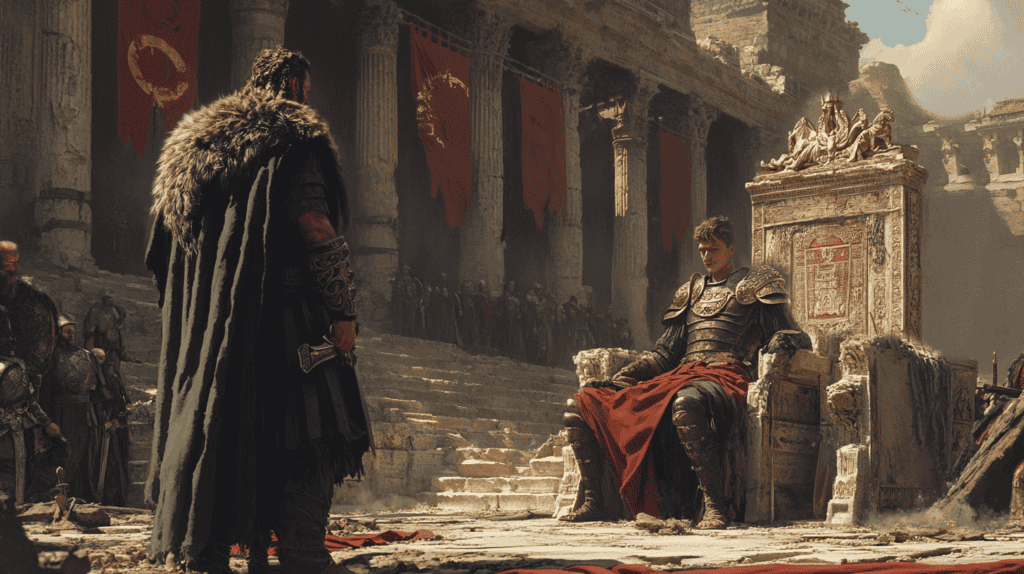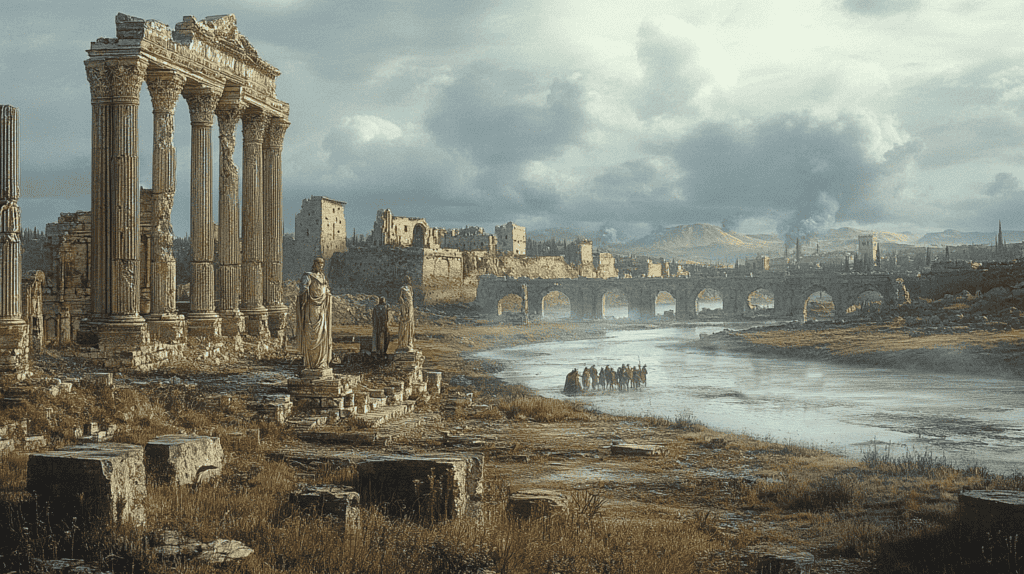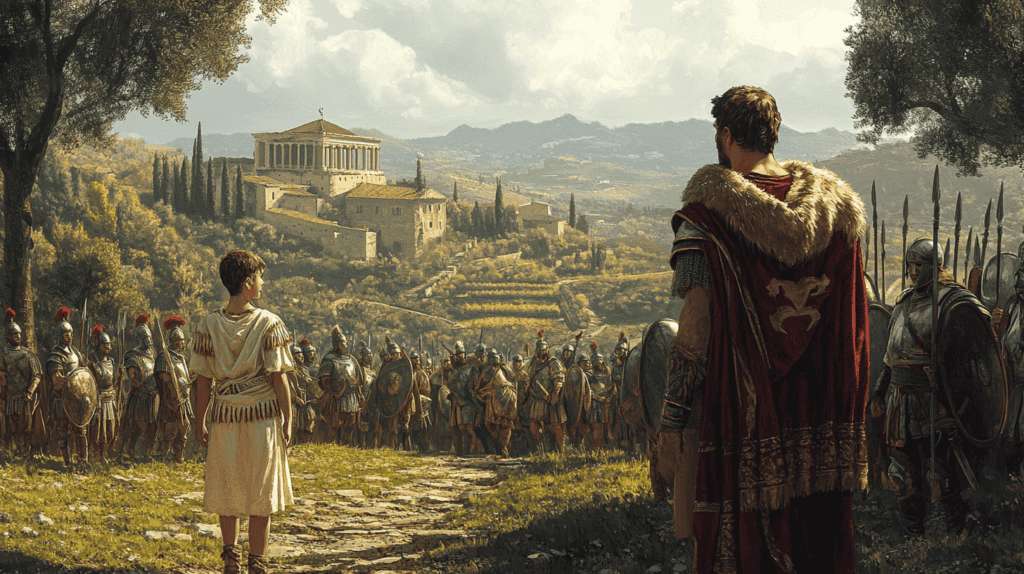
On September 4, 476 CE, a pivotal moment in world history unfolded in the city of Ravenna, Italy. The Germanic military leader Odoacer deposed the teenage Western Roman Emperor Romulus Augustulus, effectively bringing an end to the Western Roman Empire that had ruled much of Europe for centuries. This event, while not immediately recognized as epochal, would come to be seen as marking the transition from classical antiquity to the early Middle Ages.

The Decline of the Western Roman Empire
To understand the significance of Odoacer’s actions, we must first examine the context of the declining Western Roman Empire in the 5th century CE. For decades, the empire had been grappling with a multitude of challenges that steadily eroded its power and stability:
- Political turmoil and instability
- Economic decline and financial strain
- Military pressures from barbarian invasions
These factors combined to weaken the once-mighty empire, leaving it fragmented and vulnerable to external threats. The Germanic peoples, long held at bay by Roman military might, began to press into imperial territories, seeking land and opportunities. This influx of non-Roman peoples further destabilized the empire’s social and political fabric.

The Rise of Odoacer
Amidst this tumultuous period, Odoacer emerged as a powerful figure in Italy. Born around 433 CE, he was of Germanic descent but had risen through the ranks of the Roman military system. As an auxiliary general, Odoacer commanded significant influence among the non-Roman mercenary soldiers who increasingly formed the backbone of the empire’s defensive forces.
In 475 CE, the Western Roman Empire was already in a precarious state. The previous emperor, Julius Nepos, had been forced to flee Italy by the rebellion of the Roman general Orestes. Orestes, seeking to consolidate his power, placed his young son Romulus Augustulus on the imperial throne on October 31, 475.

The Deposition of Romulus Augustulus
Romulus Augustulus, whose diminutive name “Augustulus” meant “little Augustus,” was only about 16 years old when he ascended to the purple. His reign, lasting less than a year, was marked by the continued deterioration of imperial authority and mounting pressures from various factions within Italy. Odoacer, recognizing the weakness of the new regime, made a bold move. He demanded that Orestes grant land in Italy to his non-Roman mercenary soldiers. When Orestes refused, Odoacer rallied his supporters and launched a coup. The events unfolded rapidly:
- August 476: Orestes is captured and executed by Odoacer’s forces.
- September 4, 476: Odoacer’s troops capture Ravenna, the Western imperial capital.
- Romulus Augustulus is forced to abdicate before the Roman Senate.
In a surprising act of clemency, Odoacer chose not to execute the young ex-emperor. Instead, reportedly sympathetic to Romulus’s youth, he exiled him to an estate in Campania with a generous pension.

Odoacer as King of Italy
With Romulus Augustulus removed, Odoacer took a momentous step. Rather than declaring himself emperor, he assumed the title of “rex” or king. This decision marked a significant break from Roman imperial tradition and signaled the beginning of a new political order in Italy.
Odoacer’s actions were carefully calculated. He sent the Western imperial regalia to the Eastern Roman Emperor Zeno in Constantinople, ostensibly acknowledging Zeno’s supremacy. This meant Odoacer ruled Italy as a nominally subordinate king rather than as a usurping emperor. Thus, Odoacer’s rule was legitimized in the eyes of the Eastern Empire and removed any immediate threat of Eastern intervention in Italy.

The Aftermath and Historical Significance
The deposition of Romulus Augustulus and Odoacer’s ascension as King of Italy had far-reaching consequences:
- End of the Western Roman Empire: While some historians debate the exact moment of the empire’s fall, the events of 476 CE are widely considered to mark the end of the Western Roman Empire as a political entity.
- Transition to Medieval Europe: Odoacer’s rule facilitated the transition from the ancient Roman system to the medieval kingdoms that would dominate European politics for centuries to come.
- Shift in Power Dynamics: The event symbolized the shift of power from Roman to Germanic leadership in Western Europe, a trend that would continue with the rise of various “barbarian” kingdoms.
- Continuity and Change: Despite the political upheaval, many aspects of Roman administration and culture continued under Odoacer’s rule, illustrating the complex nature of this historical transition.
Debating the “Fall of Rome”
It’s important to note that the significance of the events of 476 CE was not immediately apparent to contemporaries. The idea of the “Fall of Rome” as a decisive historical moment was largely a later construction. In fact, many Romans in Italy likely saw little immediate change in their daily lives.
Several factors contribute to the complexity of this historical moment:
- Eastern Roman Empire: The Eastern half of the Roman Empire, centered in Constantinople, continued to thrive for nearly a thousand years after 476 CE.
- Julius Nepos: The previous Western Emperor, Julius Nepos, continued to claim the title and rule Dalmatia until his death in 480 CE.
- Continuity of Institutions: Many Roman institutions, laws, and cultural practices continued under Odoacer’s rule and subsequent Germanic kingdoms.
- Gradual Transformation: The transition from the Roman world to the medieval period was a gradual process that occurred over centuries rather than a sudden event.
Odoacer’s Rule and Legacy
Odoacer’s reign as King of Italy lasted from 476 to 493 CE. During this time, he attempted to balance the interests of his Germanic followers with those of the Roman aristocracy and institutions. Some key aspects of his rule include:
- Retention of Roman Administration: Odoacer largely maintained the existing Roman administrative structure, allowing for continuity in governance.
- Land Distribution: He fulfilled his promise to his troops by distributing land, a move that altered the social and economic landscape of Italy.
- Religious Policy: Odoacer, an Arian Christian, generally practiced religious tolerance towards the Catholic majority in Italy.
- Foreign Relations: He maintained diplomatic relations with the Eastern Roman Empire and other neighboring powers.
The End of Odoacer’s Rule
However, Odoacer’s rule was not destined to last. In 489 CE, the Ostrogothic king Theodoric invaded Italy at the behest of Eastern Emperor Zeno. After a four-year war, Theodoric defeated Odoacer and established the Ostrogothic Kingdom of Italy. The final confrontation, however, was marked by treachery. Theodoric invited Odoacer to a banquet and, in a shocking turn of events, personally killed his rival.

The deposition of Romulus Augustulus by Odoacer in 476 CE stands as a symbolic endpoint of the Western Roman Empire and a pivotal moment in European history. While the immediate impact may have been less dramatic than later interpretations suggest, this event set in motion changes that would shape the political, social, and cultural landscape of Europe for centuries to come.




